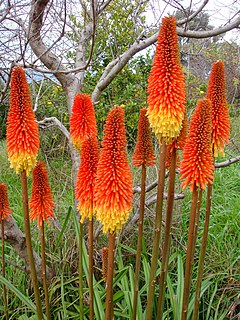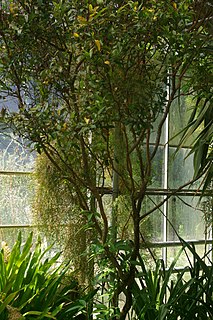
Kniphofia is a genus of perennial flowering plants in the family Asphodelaceae, first described as a genus in 1794. Species are native to Africa. Common names include tritoma, red hot poker, torch lily and poker plant.

The conservation status of a group of organisms indicates whether the group still exists and how likely the group is to become extinct in the near future. Many factors are taken into account when assessing conservation status: not simply the number of individuals remaining, but the overall increase or decrease in the population over time, breeding success rates, and known threats. Various systems of conservation status exist and are in use at international, multi-country, national and local levels as well as for consumer use.

Dracaena reflexa is a tree native to Mozambique, Madagascar, Mauritius, and other nearby islands of the Indian Ocean. It is widely grown as an ornamental plant and houseplant, valued for its richly coloured, evergreen leaves, and thick, irregular stems.

Kniphofia uvaria is a species of flowering plant in the family Asphodelaceae, also known as tritomea, torch lily, or red hot poker, due to the shape and color of its inflorescence. The leaves are reminiscent of a lily, and the flowerhead can reach up to 1.5 m (5 ft) in height. There are many varieties of torch lily, and they bloom at different times during the growing season. The flowers are red, orange, and yellow.

An IUCN Red List Critically Endangered (CR) species is one that has been categorized by the International Union for Conservation of Nature as facing an extremely high risk of extinction in the wild. As of 2021, of the 120,372 species currently tracked by the IUCN, there are 8,404 species that are considered to be Critically Endangered.

Cheirolophus crassifolius, the Maltese centaury, Maltese rock-centaury or Widnet il-Baħar, is a species of flowering plant in the family Asteraceae. It is endemic to Malta, where it has been the national plant of Malta since 1973. Its natural habitats are cliffs and coastal valleys. It is threatened by habitat loss.

Carpoxylon macrospermum is a species of palm tree endemic to Vanuatu, and the only species in the genus Carpoxylon.

Juania australis, the Chonta palm, is a species of flowering plant in the family Arecaceae, the only species in the genus Juania. It is a solitary trunked palm tree which is endemic to the Juan Fernández Islands archipelago in the southeast Pacific Ocean west of Chile.

Jubaeopsis caffra, the Pondoland palm, is a flowering plant species in the palm family (Arecaceae). It belongs to the monotypic genus Jubaeopsis.

Nephrosperma vanhoutteanum is a species of palm tree, and the only species in the genus Nephrosperma. It is found only in Seychelles, where it is threatened by habitat loss.

Pelagodoxa henryana is a species of palm tree, and the only species in the genus Pelagodoxa. It is found only in the Marquesas Islands of French Polynesia, where it is threatened by habitat loss.

The white-bellied sunbird, also known as the white-breasted sunbird, is a species of bird in the family Nectariniidae. It is found in Angola, Botswana, Democratic Republic of the Congo, Eswatini, Malawi, Mozambique, Namibia, South Africa, Tanzania, Zambia, and Zimbabwe.

The Aldabra flying fox is a species of megabat in the genus Pteropus. It is endemic to the Aldabra Atoll in the Seychelles, like Chaerephon pusilla, though the latter may be the same species as the little free-tailed bat.
Nectandra reflexa is a species of plant in the family Lauraceae. It is found in Ecuador and Peru.

Ocotea porosa is a species of plant in the Lauraceae, often placed in the related genus Phoebe. It is commonly called imbuia or Brazilian walnut because its wood resembles that of some walnuts. The tree is a major commercial timber species in Brazil, used for high-end furniture, mostly as decorative veneers, and as flooring. The wood is very hard, measuring 3,684 lbf on the Janka scale. The wood is also fragrant with hints of nutmeg and cinnamon. The tree is also a popular horticultural tree in subtropical regions of the world. In its native habitat it is a threatened species.

Tetrataxis is a genus of plant in family Lythraceae. The sole species is Tetrataxis salicifolia. It is endemic to Mauritius. Its natural habitat is subtropical or tropical dry forests.

A vulnerable species is a species which has been categorized by the International Union for Conservation of Nature that is threatened with extinction unless the circumstances that are threatening its survival and reproduction improve.
Melicope reflexa, the reflexed pelea or lava melicope, is a species of flowering plant in the family Rutaceae. It is endemic to Hawaii, where it is found only on the island of Molokai. Like other Hawaiian Melicope, this species is known as alani. It is a federally listed endangered species of the United States.

Kniphofia umbrina, called the Eswati poker, is a species of flowering plant in the genus Kniphofia. The species is native to an area near Forbes Reef in Eswatini, just to the north of Mbabane.

Kniphofia × praecox, also known as Kniphofia praecox or the greater red-hot poker is a species of flowering plant in the family Asphodelaceae.
















